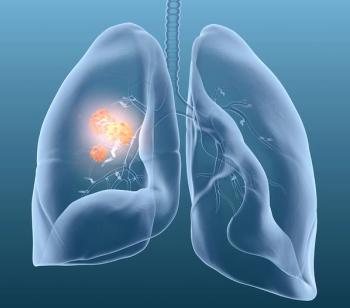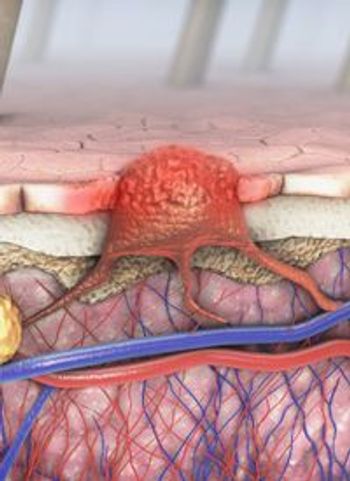
- ONCOLOGY Vol 14 No 6
- Volume 14
- Issue 6
Pentostatin and Rituximab in the Treatment of Patients With B-Cell Malignancies
Both pentostatin (Nipent) and rituximab (Rituxan) have single-agent activity in B-cell malignancies, including indolent and intermediate-grade non-Hodgkin’s lymphoma (NHL). Pentostatin is also active in pretreated patients
ABSTRACT: Both pentostatin (Nipent) and rituximab (Rituxan) have single-agent activity in B-cell malignancies, including indolent and intermediate-grade non-Hodgkins lymphoma (NHL). Pentostatin is also active in pretreated patients with chronic lymphocytic leukemia (CLL). In spite of current treatment modalities, few patients with these diseases are cured. The combination of rituximab and pentostatin is an attractive treatment option because both drugs have a limited toxicity profile and can be delivered on an outpatient basis. We describe the design of a phase II multicenter study to evaluate the safety and efficacy of pentostatin in combination with rituximab in patients with previously treated and untreated low-grade NHL and CLL. [ONCOLOGY 14(Suppl 2):25-29, 2000]
Adenosine deaminase is concentrated in lymphoid tissue, including both T and B cells; however, the cytotoxic effect of pentostatin in humans is independent of intracellular concentrations of adenosine deaminase. Response rates of 25% to 32% are seen in heavily pretreated patients with B-CLL[2-6] and indolent lymphomas.[7-9] Responses reported after treatment with 2-chlorodeoxyadenosine (cladribine, [Leustatin]), fludarabine (Fludara), and alkylating agents suggest possible noncross-resistance to pentostatin.
Pentostatin is active in CLL, achieving response rates between 18% and 35% in patients heavily pretreated with cytotoxic chemotherapy.[2-6] Phase II studies of single-agent pentostatin in heavily pretreated patients with low- or intermediate-grade NHL report response rates between 17% and 23% (Table 1).[7-9] The majority of these responses occurred in the low-grade NHL patients. Combining these reports, the response rate for pentostatin in low-grade NHL is 26%. The efficacy of pentostatin in untreated patients with CLL or NHL has not been explored.
Phase II Study
A phase II study was conducted in patients with CLL who received single-agent pentostatin at an intravenous dose of 4 mg/m²/wk for 3 weeks initially, then every 2 weeks.[3] The observed toxicities are listed in Table 2. In the study by Dillman et al,[3] severe toxicity was uncommon in the presence of normal renal function and normal bone marrow reserve. The most frequent grade 1 to 2 toxicity was nausea and vomiting, and it occurred in approximately 50% of patients. The majority of patients did not experience neutropenia or anemia.
However, infection was a major, life-threatening complication. Grade 3 to 5 infections occurred in 34% of patients. These patients were heavily pretreated, and infections are expected to occur in such immunodeficient populations. By definition, patients with B-cell malignancies have an immune deficiency, and this deficiency is increased initially by pentostatins depression of both T and B lymphocytes.
Phase I Study
Among the first 300 patients enrolled in a phase I trial, the overall incidence of grade 3 to 5 infections was 8%.[10] This included viral, fungal, and bacterial infections of both high and low pathogenicity. Cummings et al[9] administered pentostatin to 37 patients with refractory lymphomas and cutaneous T-cell disease at a dose of 5 mg/m²/d for 3 days, every 3 weeks. Three patients developed grade 4 infections and two died from infection.
It is important to note that these trials were conducted before the widespread use of hematopoietic growth factors.
Abating Toxicity
To prevent infectious complications, all patients with B-cell malignancies treated with pentostatin should receive prophylaxis for both viral and opportunistic infections, when indicated, with trimethoprim-sulfamethoxazole and acyclovir. When neutropenic, patients should receive growth factor support with granulocyte colony-stimulating factor (Neupogen) or granulocyte-macrophage colony-stimulating factor (Leukine, Prokine).
Furthermore, to decrease overall toxicity, a dose of 4 mg/m² of pentostatin administered on an every-other-week schedule has been recommended.[5,11] With such a dose and schedule, it is unlikely that prohibitive toxicity will develop, making pentostatin a patient-friendly drug.
Rituximab (Rituxan) is a genetically engineered chimeric murine/human monoclonal antibody directed against the CD20 antigen found on the surface of normal and malignant B lymphocytes. The antibody is an immunoglobulin Gk containing murine light- and heavy-chain variable sequences and human constant region sequences.[12] It is produced by suspending Chinese hamster ovary cell cultures in a nutrient medium. The antibody is purified by affinity and ion exchange chromatography, resulting in a sterile, preservative-free liquid concentrate for intravenous administration.
The Fab domain of rituximab binds to the CD20 antigen on B lymphocytes, and the Fc domain recruits immune effector functions to mediate B-cell lysis in vitro. Possible mechanisms of cell lysis include complement-dependent cytotoxicity and antibody-dependent cellular cytotoxicity.[12] Rituximab binding occurs on lymphoid cells in the thymus, in the white pulp of the spleen, and on the majority of B lymphocytes in the peripheral blood and lymph nodes.
In patients given 375 mg/m² of rituximab as an intravenous infusion, the serum half-life may be proportional to the B-cell burden and ranges from 11.1 to 104.6 hours.[13] The pharmacokinetic profile of rituximab remains unaffected by concomitant chemotherapy with CHOP (cyclophosphamide, doxorubicin, Oncovin, and prednisone).[14] Administration of rituximab results in a rapid and sustained depletion of circulating and tissue-based B cells. B-cell recovery begins 6 months after 4 weekly cycles of rituximab at 375 mg/m² and returns to normal by 12 months.[13]
Pretreatment Abates Toxicity
A phase III study demonstrated a 48% (80 of 166) response rate in previously treated outpatients with low-grade and follicular B-cell lymphoma who received intravenous rituximab at 375 mg/m² once per week for 4 weeks.[15,16] Of these responses, 6% were complete responses and the remainder (42%) partial responses. Adverse events were observed during the first infusion and were generally mild. They included fever, chills, headache, nausea, vomiting, rhinitis, bronchospasm, leukopenia, and grade 1 to 2 hypotension.[14] Among the 619 adverse events reported during therapy, 18 were grade 3 events and two were grade 4 events (arrhythmia, 1; neutropenia, 1).[16] Table 3 summarizes the toxicity profile of single-agent rituximab.
The initial phase I study of rituximab used no pretreatment medications; consequently, nearly 80% of patients in that trial experienced some toxicity during the first rituximab infusion. At present, premedication with corticosteroids, antihistamines, and antiemetics is routine, and the majority of patients experience little toxicity. Rituximab, therefore, has a better safety profile compared to combination chemotherapy in low-grade malignant lymphoma.
Studies previously cited in this article have confirmed that both pentostatin and rituximab have single-agent activity in B-cell malignancies, including indolent and intermediate-grade NHL, and that pentostatin is clearly active in CLL. These results led us to design a phase II multicenter trial to evaluate the safety and efficacy of pentostatin in combination with rituximab in patients with low-grade NHL and CLL. In all patients, qualitative and quantitative toxicities, as well as their duration and reversibility, will be assessed. Response rates and the durability of objective responses will also be evaluated.
Study Design and Drug Administration
Initially, the study will enroll a maximum of 25 patients with low-grade NHL and 25 patients with CLL, with the goal of obtaining 40 evaluable patients. The study, if successful, may be expanded to include 50 patients with low-grade NHL and 50 patients with CLL. During the first week, on day 1 of the study, each patient will receive an intravenous infusion of rituximab at 375 mg/m². Patients will be given pretreatment corticosteroids, antihistamines, and antiemetics as needed. On day 8, each patient will receive the second dose of rituximab and the first dose of intravenous pentostatin at 4 mg/m². Both drugs will be repeated on days 15 and 22.
A rest period will follow after day 22, and the combination will be repeated on days 36, 43, and 50. After day 50, patients will be evaluated for response. Patients who progress prior to or by day 50 will be off study. Patients with a partial response by day 50 will repeat days 8 through 50 with an additional six cycles of both drugs. Patients in complete remission at day 50 will not require further therapy. Figure 1 outlines the treatment scheme.
NHL Patients
EligibilityPatients must have histologically proven low-grade NHL as defined by the International Working Group classification.[17] They must have: (1) measurable tumor size; (2) an expected survival of more than 6 months; (3) Cancer and Leukemia Group B (CALGB) performance status of 0 to 2 or Karnofsky performance status greater than 60%; and (4) received no more than four prior chemotherapy drugs, not including corticosteroids or immunotherapy.
Evaluation of ResponseResponse to treatment will be assessed at days 57 to 64 and then at 9-week intervals. Evaluation will be based on physical examination and imaging studies, including computed tomography scans, magnetic resonance imaging, and other radiologic assessments of extent of disease. The best response achieved will be considered in the analysis.
Parameters for responses are as follows: A complete response is defined as no apparent disease; a partial response is a 50% decrease from baseline tumor size for 28 days (as measured by the product of two perpendicular measurements) with no areas of disease progression. Stable disease is less than a 25% increase in the size of any measurable lesion, and progressive disease is more than a 25% increase in the size of any lesion.
CLL Patients
EligibilityFor this study, a diagnosis of B-CLL will be made according to criteria as defined by the National Cancer Institutesponsored working group.[18] Patients eligible for treatment must be in the intermediate- or high-risk categories of the modified three-stage Rai staging system.[19] Patients must be over 18 years of age; have a CALGB performance status of 0 to 2 or a Karnofsky status of more than 60%; and must have received no more than four prior chemotherapeutic drugs, excluding corticosteroids and immunotherapy. In low-risk Rai stage 0 patients, lymphocytosis occurs in the peripheral blood, and is characterized by more than 5,000 lymphocytes/µL and over 3% nucleated bone marrow cells.
Intermediate-risk Rai stage I encompasses the above criteria plus enlarged lymph nodes, while intermediate-risk Rai stage II also includes splenomegaly and/or hepatomegaly.
High-risk Rai stage III incorporates all of the previous criteria plus anemia, as indicated by a hemoglobin concentration of less than 11 g/dL. Rai stage IV includes the above criteria for lymphocytosis plus a platelet count of < 100,000/µL.
Evaluation of ResponseA complete response is defined as no lymphadenopathy or hepatosplenomegaly, and a normal complete blood cell count (leukocytes > 1,500/µL, platelets > 100,000/µL, hemoglobin > 11.0 g/dL, lymphocytes < 5,000/µL). The bone marrow must also be normal for age, with less than 30% of the nucleated cells being lymphocytes. A partial response is defined as a greater than 50% decrease in peripheral blood lymphocytes, lymphadenopathy, and hepatosplenomegaly. A partial response also requires: (1) a leukocyte count > 1,500/µL or a 50% increase from initial value; (2) a platelet count > 100,000/µL or a 50% improvement from initial value; and (3) a hemoglobin level greater than 11 g/dL or a 50% improvement from initial value.
Conclusions
Both pentostatin and rituximab have single-agent activity in B-cell malignancies, including indolent NHL and CLL. In spite of current treatment modalities, few patients with these diseases are cured. The combination of rituximab and pentostatin is attractive as a treatment option since both drugs have a limited toxicity profile and can be delivered on an outpatient basis. A phase II multicenter study will evaluate the safety and efficacy of pentostatin in combination with rituximab in patients with previously treated and untreated low-grade NHL and CLL.
References:
1. Brogden RN, Sorkin ME: Pentostatin: A review of its pharmacodynamic and pharmacokinetic properties, and therapeutic potential in lymphoproliferative disorders. Drugs 46:652-677, 1993.
2. Dearden C, Catovsky D: Deoxycoformycin in the treatment of mature B-cell malignancies. Br J Cancer 62:4-5, 1990.
3. Dillman RO, Mick R, McIntyre OR: Pentostatin in chronic lymphocytic leukemia: A phase II trial of Cancer and Leukemia Group B. J Clin Oncol 7:433-438, 1989.
4. Ho AD, Thaler J, Stryckmans P, et al: Pentostatin in refractory chronic lymphocytic leukemia: A phase II trial of the European Organization for Research and Treatment of Cancer. J Natl Cancer Inst 82:1416-1420, 1990.
5. Grever MR, Leiby JM, Kraut EH, et al: Low-dose deoxycoformycin in lymphoid malignancy. J Clin Oncol 3:1196-1201, 1985.
6. Johnson S, Catovsky D, Child J, et al: Phase I/II evaluation of 2´deoxycoformycin in a 5-day schedule for the treatment of relapsed/refractory chronic lymphocytic leukemia (abstract). Blood 86(suppl 1):590a, 1996.
7. Monfardini S, Sorio R, Cavalli F, et al: Pentostatin (2´deoxycoformycin, dCF) in patients with low-grade (B-T-cell) and intermediate- and high-grade (T-cell) malignant lymphomas: Phase II study of the EORTC Early Clinical Trials Group. Oncology 53 (Basel):163-168, 1996.
8. Duggan DB, Anderson JR, Dillman R, et al: 2´Deoxycoformycin (pentostatin) for refractory non-Hodgkins lymphoma: A CALGB phase II study. Med Pediatr Oncol 18:203-206, 1990.
9. Cummings FJ, Kim K, Neiman RS, et al: Phase II trial of pentostatin in refractory lymphomas and cutaneous T-cell disease. J Clin Oncol 9:565-571, 1991.
10. ODwyer PJ, Spiers AS, Marsoni S: Association of severe and fatal infections and treatment with pentostatin. Cancer Treat Rep 70:1117-1120, 1986.
11. Kraut EH, Bouroncle BA, Grever MR: Low-dose deoxycoformycin in the treatment of hairy cell leukemia. Blood 68:1119-1122, 1986.
12. Reff ME, Carner K, Chambers KS, et al: Depletion of B cells in vivo by chimeric mouse human monoclonal antibody to CD20. Blood 83:435-445, 1994.
13. Maloney DG, Grillo-López AJ, Bodkin DJ, et al: IDECC2B8: Results of a phase I multiple-dose trial in patients with relapsed non-Hodgkins lymphoma. J Clin Oncol 15:3266-3274, 1997.
14. Czuczman MS, Grillo-López AJ, White CA, et al: Treatment of patients with low-grade B-cell lymphoma with the combination of chimeric anti-CD20 monoclonal antibody and CHOP chemotherapy. J Clin Oncol 17:268-276, 1999.
15. McLaughlin P, Grillo-López A, Czuczman M, et al: Preliminary report on a phase III pivotal trial of the anti-CD20 antibody (MAB) IDEC-C2B8 in patients with relapsed low-grade or follicular lymphoma (abstract). Proc Am Soc Clin Oncol 15:417, 1996.
16. McLaughlin P, Grillo-López AJ, Link BK, et al: Rituximab chimeric anti-CD20 monoclonal antibody therapy for relapsed indolent lymphoma: Half of patients respond to a four-dose treatment program. J Clin Oncol 16:2825-2833, 1998.
17. The Non-Hodgkins Lymphoma Pathologic Classification Project: National Cancer Institute sponsored study of classifications of non-Hodgkins lymphomas: Summary and description of a working formulation for clinical usage. Cancer 9:2112-2135, 1982.
18. Cheson BD, Bennett JM, Grever M, et al: National Cancer Institute-sponsored working group guidelines for chronic lymphocytic leukemia: Revised guidelines for diagnosis and treatment. Blood 87:4990-4997, 1996.
19. Rai KR, Sawitsky A, Cronkite EP, et al: Clinical staging of chronic lymphocytic leukemia. Blood 46:219-234, 1975.
Articles in this issue
over 25 years ago
Purine Nucleoside Analogs in Indolent Non-Hodgkin’s Lymphomaover 25 years ago
3D CRT More Cost-Effective Than Conventional RT for Prostate CancerNewsletter
Stay up to date on recent advances in the multidisciplinary approach to cancer.
































































































